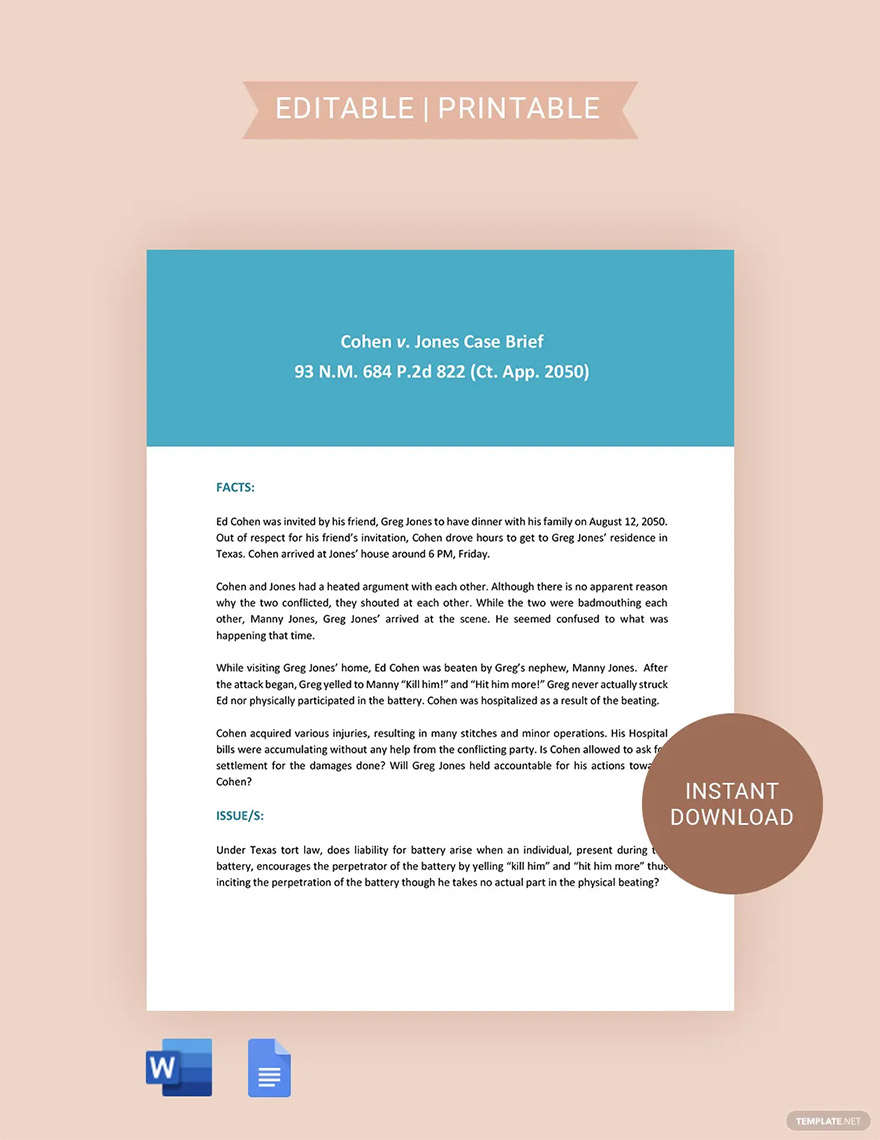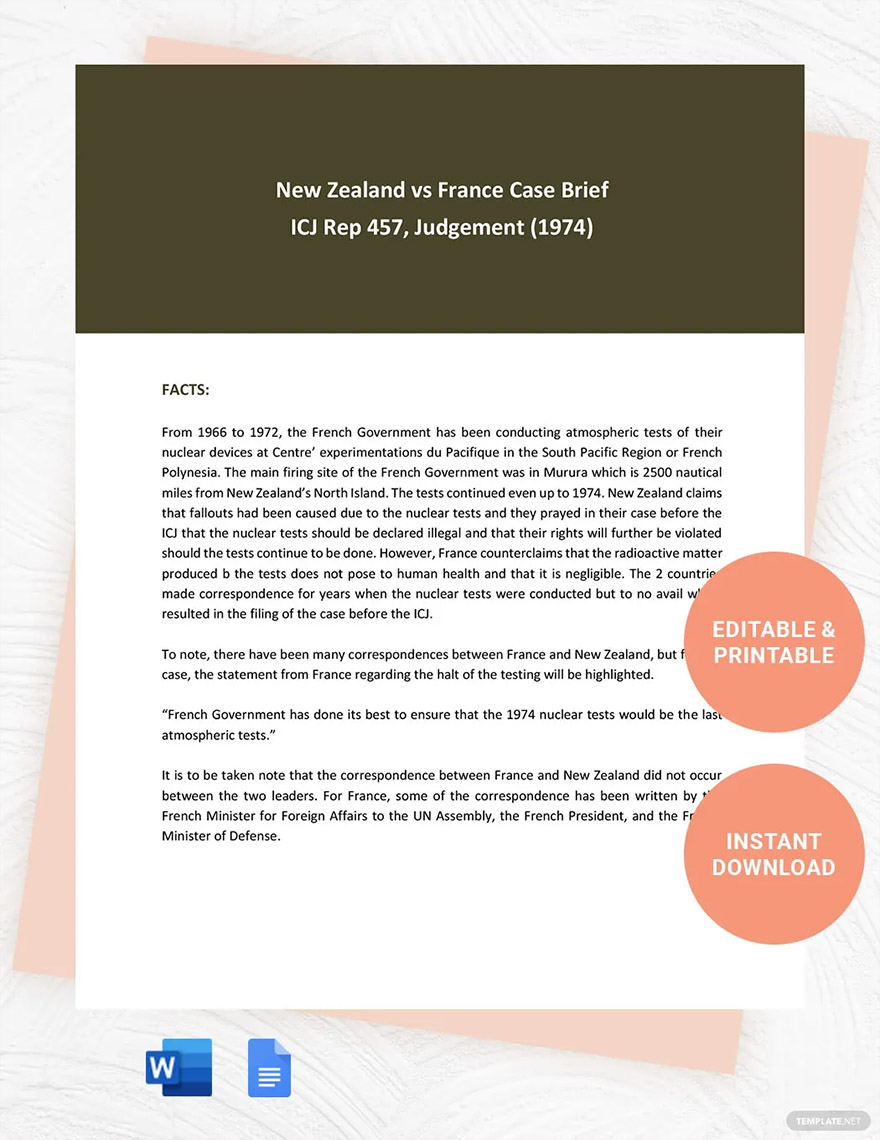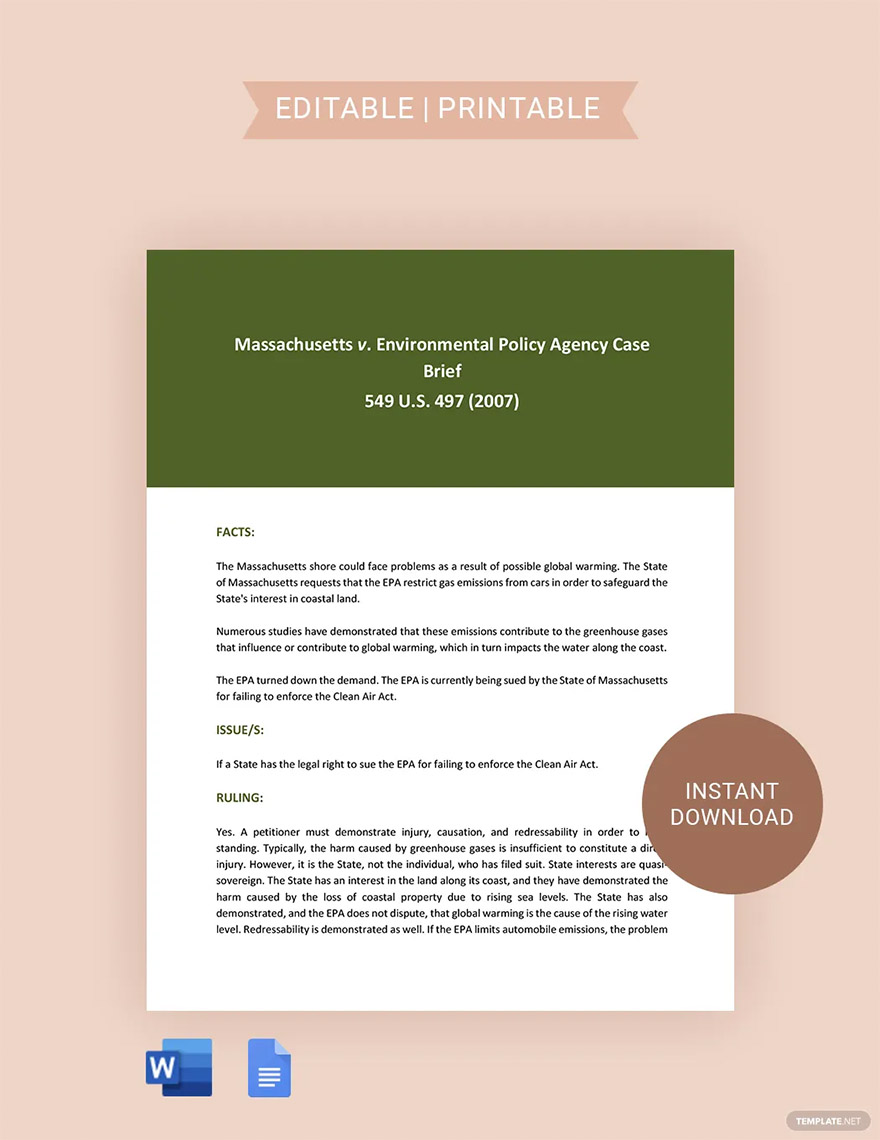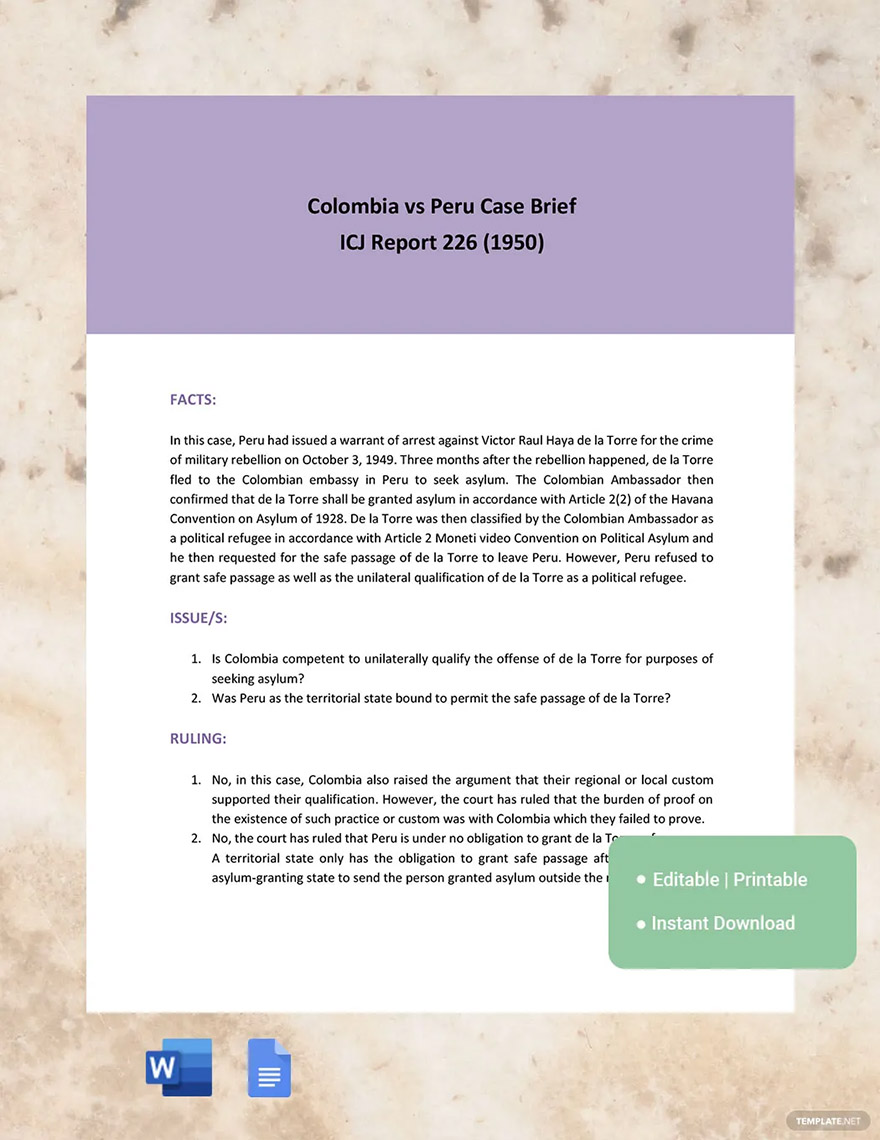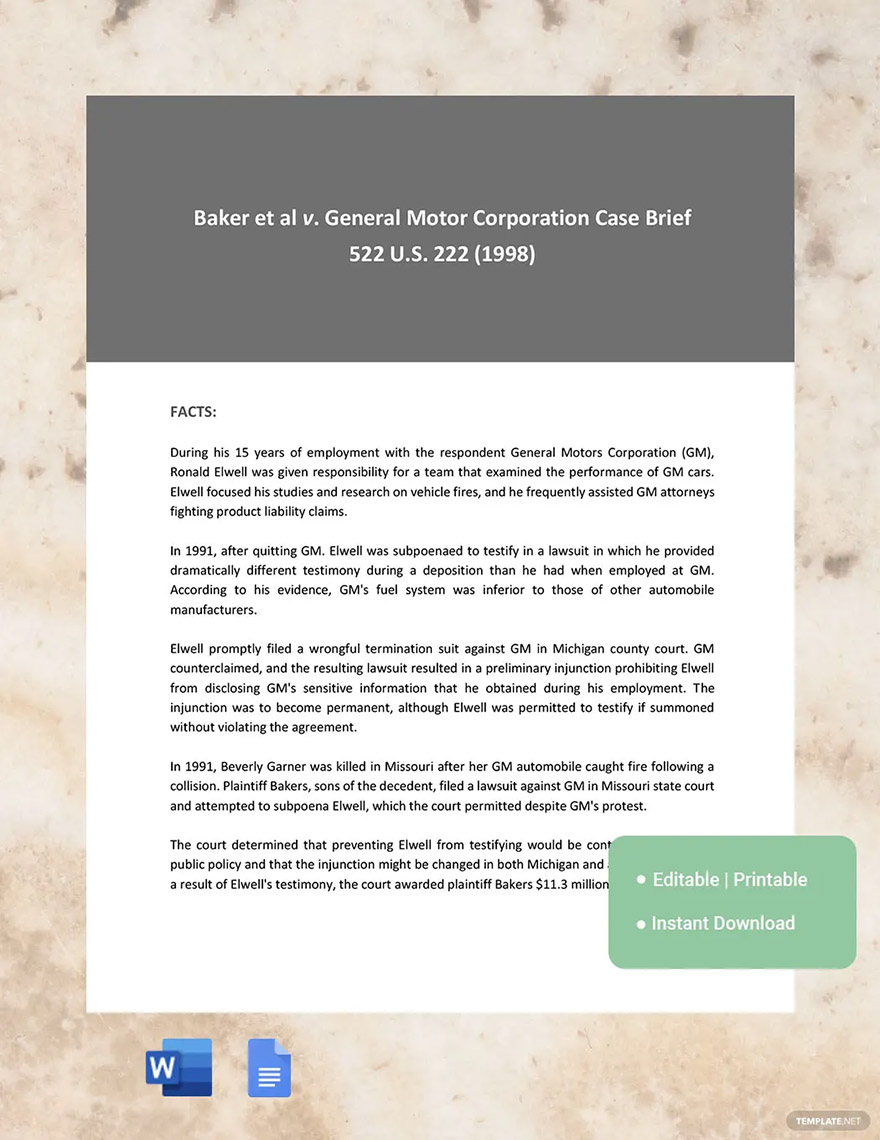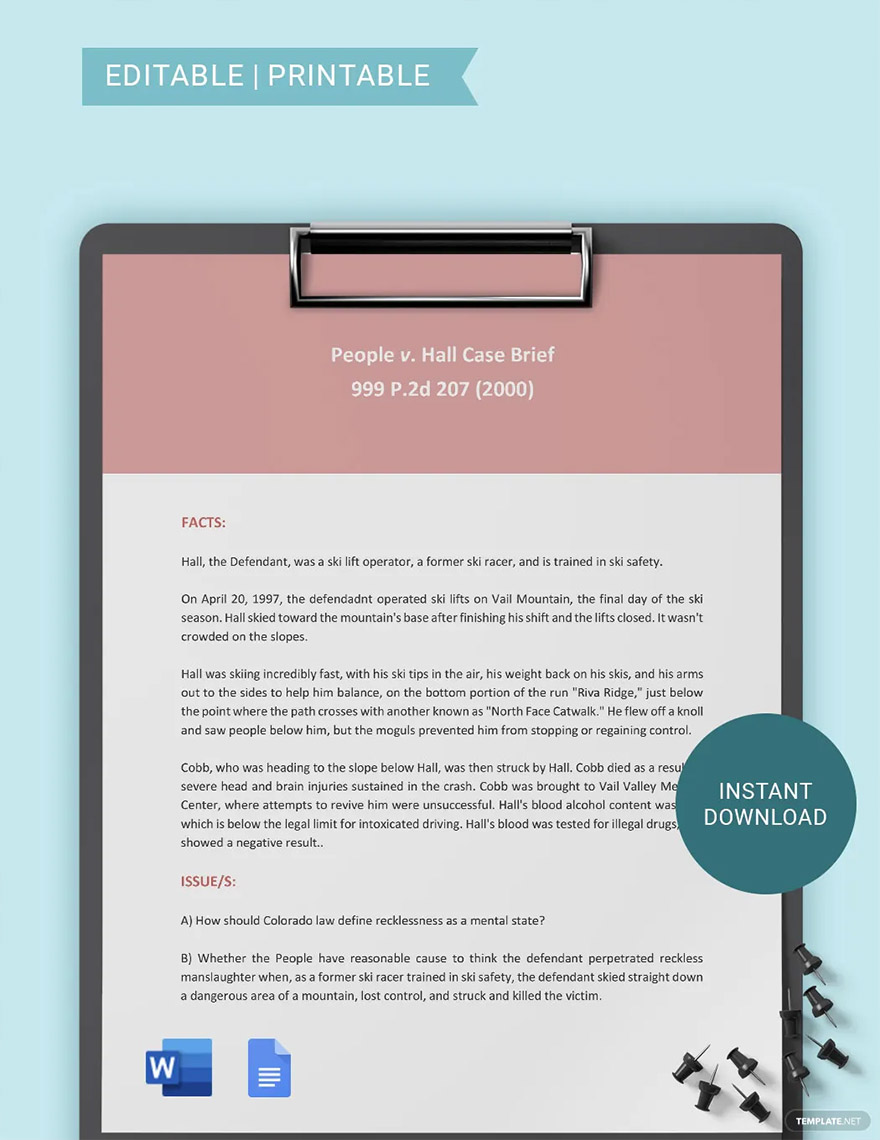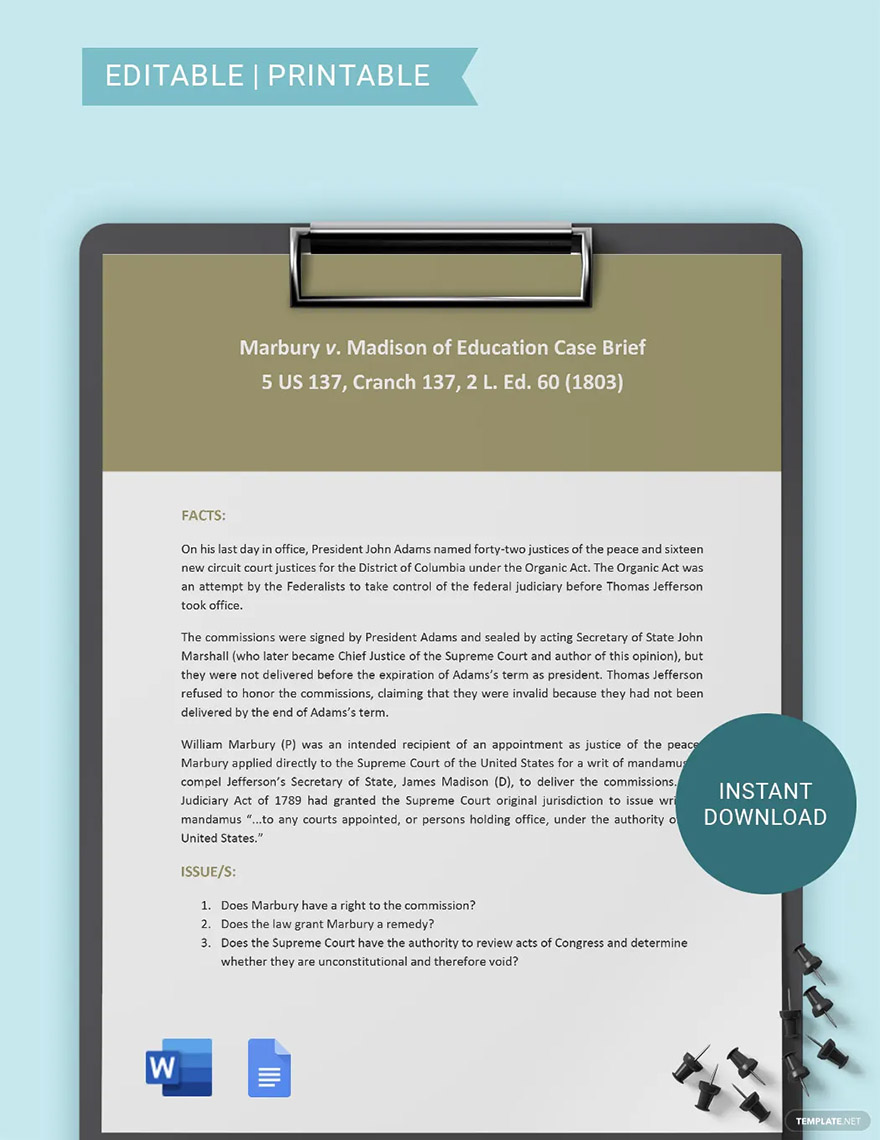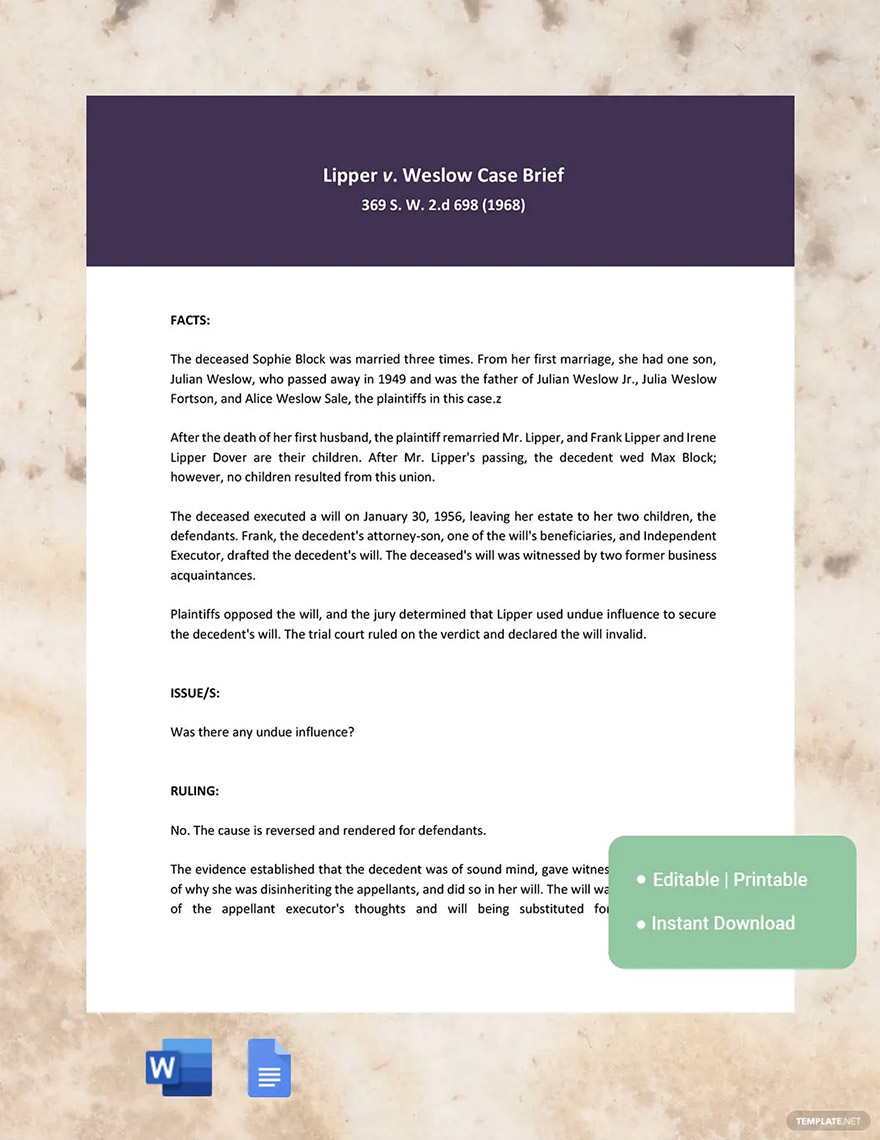Table of Contents
- Case Brief Definition & Meaning
- What is a Case Brief?
- 10 Types of Case Briefs
- Case Brief Uses, Purpose, Importance
- What’s in a Case Brief? Parts?
- How to Design a Case Brief?
- Case Brief Vs. Case Study
- What’s the Difference Between a Case Brief, Summary & Memorandum?
- Case Brief Sizes
- Case Brief Ideas & Examples
- FAQs
Case Brief
Case briefs are valuable documents for students that are aiming to become lawyers and attorneys in the future by helping them identify and cover the essential parts of a judicial trial. When developing case briefs, remember the guidelines that individuals from post-college graduation must apply, including the correct format, structure, and layout when incorporating the information.
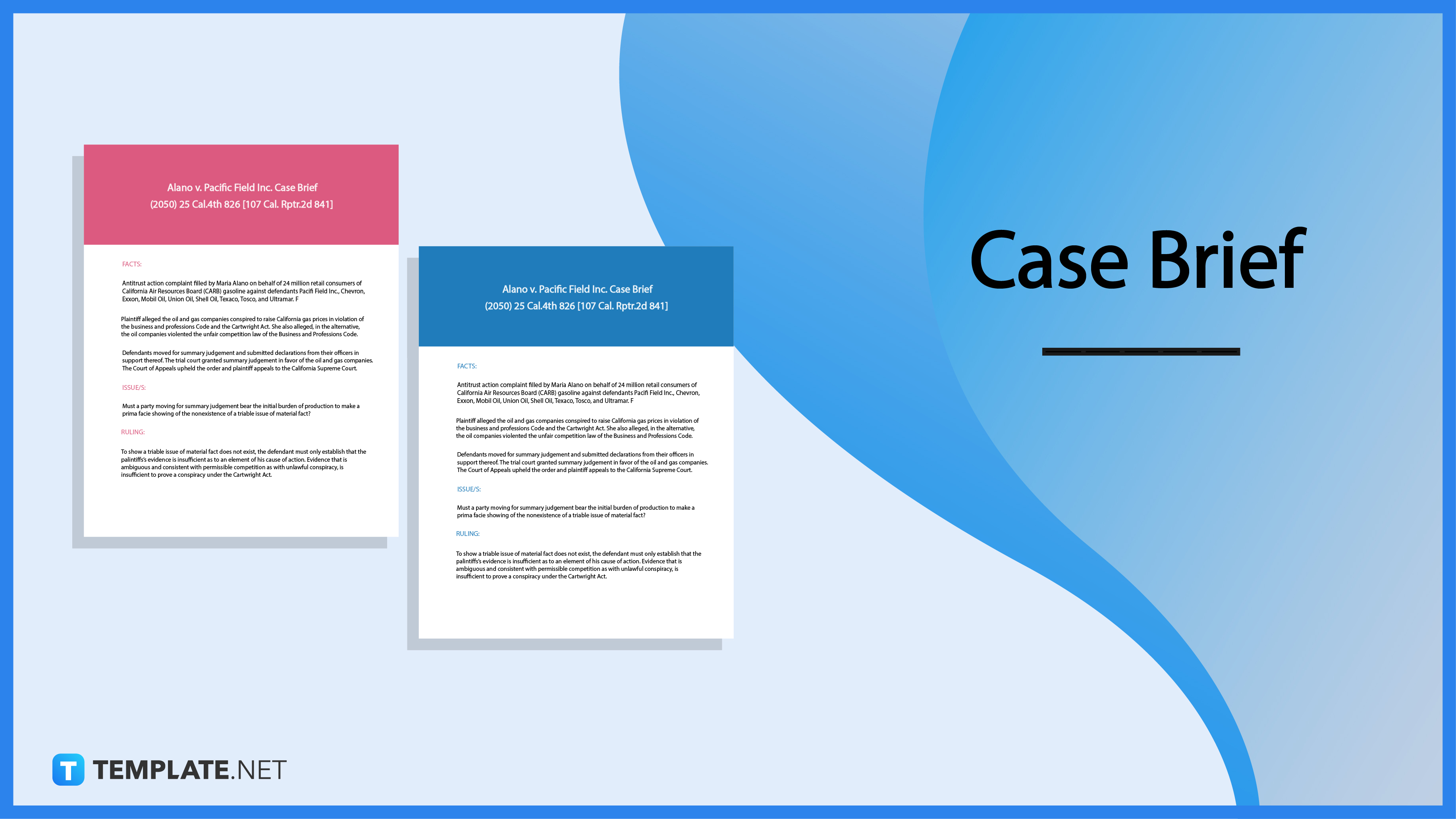
Case Brief Definition & Meaning
A case brief is a written explanation of the fundamental points of a particular court decision. It is a dissection of a judicial opinion.
Trial and appellate persuasive briefs are case briefs that are the official papers that an attorney submits to a court to argue for their client’s viewpoint.
What is a Case Brief?
A case brief contains a written summary of a court ruling that summarizes facts, background, problems, resolution, and logic of a particular case. Case summaries are valuable because they highlight the key elements of a case, making it simpler to combine the data. Additionally, it provides an overview of the legal concepts and guidelines formed in a case, places cases about other course content, and serves as an excellent study aid.
10 Types of Case Briefs
Law School Case Brief
Law school case briefs are documents that post-education students use as a collection of notes highlighting essential details from each assigned case and using them during class discussions. The case brief is the product of case reading, re-reading it, disassembling it, and reassembling it. The case brief is a helpful self-study and reference tool, similar to a cheat sheet for class participation.
Student Case Brief
Student case briefs are documents containing a case summary and analysis of a specific case for discussion that a student prepares beforehand. It is a collection of notes organized methodologically to classify the parties, identify the issues, determine the resolution, and examine the justifications for the court’s rulings. Check with your instructor to be sure the format for briefing cases is appropriate before committing to a procedural structure.
Legal Case Brief
A legal case brief is a written legal document that sums up and summarizes a legal case or opinion, with the legal opinion authored by a court. Although the case brief has a more formal structure, it is a note-taking tool for individuals. The case brief is mostly used by law students in a classroom context, although lawyers and judges can also use it in actual practice.
Case Brief Outline
A case brief outline contains a summary of a specific case file that the individual is currently tackling for a discussion. The outline includes the facts, court decisions, and other information that enables an individual to write the necessary content to create a coherent document about the case. When developing the case brief outline, follow guidelines or requirements like writing in APA Style for section headings.
Business Case Brief
A business case brief is a project management document detailing how advantages outweigh its drawbacks and justify its execution. Creating case briefs happen at the project’s beginning phase, including all project goals, expenses, and benefits, while persuading stakeholders of the project’s worth. Presenting a business case convinces clients, consumers, or stakeholders that the project is a wise investment.
Law Case Brief
A law case brief is a legal document that contains a summary of a legal case and opinions from a court judge during a court case. Several structural requirements and formats individuals follow since it becomes a legal document. Print the final law case brief on standard-sized white paper the system or institution instructs its courts, either the legal or A4 size.
Case Brief Summary
Case brief summaries make it easier for law students to understand and analyze a specific case that instructors discuss during class sessions. These documents help individuals to have a deeper understanding of the case by identifying facts, issues, decisions, and reasonings during a legal case. The summary is a valuable document for many students, acting as a cheat sheet during class discussions.
Case Study Brief
A well-written case study brief offers context and direction, lays out expectations and goals, and clarifies the target audience, tone, and messaging. The content creation process goes smoothly and quickly after presenting a strong case study brief. The writer will be more likely to receive the desired outcome promptly and with greater assurance.
Simplified Case Briefing
Simplified case briefing focuses on getting all the information into the document by removing all the unnecessary details. The case briefing only focuses on the principal components of case briefs, including facts, issues, decisions, and reasoning behind the case. Students print out the legal file like a memo to only incorporate the details of the case.
IRAC Case Brief
IRAC stands for issue, rule, application, and conclusion and is a structure for legal analysis. The document appeals to incorporate the issue, rule, application, and conclusion surrounding a case for a party. The person writing the IRAC case brief eliminates all other information that does not have any relation to the case.
Case Brief Uses, Purpose, Importance
Case briefs are essential documents for many individuals learning the practice of law and employing these practices in a court after becoming court lawyers and attorneys. Before becoming part of legal businesses, case briefs are a learning tool for many aspiring lawyers, teaching them a lesson on case analysis and management. There are multiple uses for case briefs and individuals must know about them as they start using case briefs as part of their learning journey.
Acts as a Study Aid
A case brief helps students to thoroughly understand a specific case and all its components by writing clear and coherent information in the document. It helps encapsulate and analyze mountainous information students digest during law school through uncomplicated means. It is the outcome after reading a specific case, dissecting it, and putting it back together to form a coherent document.
Enables Individuals to Read Cases Carefully
Students generate a case brief to their advantage, reading the case files repetitively and carefully to gain the necessary information to understand the nature of a case. Case briefs require individuals to re-read cases, carefully emphasizing information about the case, and create a summary of it. Developing the case brief enables individuals to read through all the case components to generate a meaningful and informative document.
Prepares Students for Class
A case brief is a student study tool that helps students to prepare for their classes for each case analysis session. After briefing cases, students can understand and remember information better, while having a summary during class. Generating the case brief is a quick reference when professors ask students for vital information, providing necessary information resources.
Predict How Future Cases Will Go
In addition to examining the case itself, college and university professors inquire into the potential future implications. Predicting how a court will utilize earlier cases to make decisions in current cases is a crucial aspect of the law profession. Identifying when a case will serve as a guideline for future decisions and when it is not is vital for case analysis and briefing.
Raw Material for Compiling Course Outlines
Case summaries provide the foundation for creating a course outline, which is a crucial step in starting law school exams. An outline effectively arranges the important linked ideas in an area of law, with case briefs assisting individuals to remember the facts triggering a particular rule. Individuals can identify any facts and the rules they invoke to forecast the outcome of the new case if an exam questionnaire asks to examine new hypothetical facts.
What’s in a Case Brief? Parts?
Title
The name of the party who filed the lawsuit and the condemned party in a particular court are listed in the case’s title, indicating who is opposing whom.
Citation
Knowing the case title, one can locate the citation using the case digest for that court, with it instructing how to find the case report in the proper case reporter.
Case Facts
Indicate a summary of the relevant facts and legal arguments made in the case, outlining the nature of the dispute, the parties involved, the events that led to each party’s lawsuit, and what transpired in lower courts.
Case Issues
The court frequently expresses concerns or legal questions by unique case circumstances while occasionally misstating the issues brought up by the parties on appeal, the lower court’s opinion, or the character of the case.
Case Decision
The decision or judgment is the court’s response to a query posed to it by the parties involved or that the court itself raised through its analysis of the case.
Reasoning
The reasoning or rationale represents a list of arguments coming from the judge or a majority to rule as they did for the case through a bulleted list or paragraphs.
Separate Opinions
To highlight the key areas of agreement or disagreement with the majority opinion, it is significant to analyze concurring and dissenting views.
Case Analysis
The case analysis section assesses the case’s significance, its relation to previous cases, historical importance, court realizations, its judges, how they make decisions, or how it affects litigants, governments, or society.
How to Design a Case Brief?
1. Determine the case brief size
2. Specify the purpose of creating the case brief
3. Select from various case brief templates
4. Identify case title, caption, and facts
5. Outline procedures
6. Identify the issues
7. Generate the decisions and rationale behind them
8. Write the case analysis and separate opinions
Case Brief Vs. Case Study
A case brief contains a written summary of a case, containing the basic decisions that happened during the hearing and the components leading to a particular decision.
A case study, on the other hand, is an in-depth study or analysis of a specific person, group, or event to identify patterns and causes of behavior.
What’s the Difference Between a Case Brief, Summary & Memorandum?
A case brief is a document that lists a summary of the principal points regarding a case and the court’s decision, distilling its essential elements.
A case summary contains descriptions of facts, legal reasoning, and procedural history of a specific case discussing legal implications and impacts of the case.
A case memorandum is a fact-based background describing a subject case, legal issues statement for discussion, a brief introduction, an analysis of applicable laws, and a conclusion.
Case Brief Sizes
Case briefs are vital documents for law students in law schools as they serve as a guide or study aid for these future legal attorneys and lawyers in encapsulating and analyzing different legal cases. Generate a case brief size for a document to hold all the necessary information an individual needs to understand and investigate case contents.
- Letter (8.5 x 11 inches)
- Legal (8.5 x 14 inches)
- A4 (8.3 × 11.7 inches)
Case Brief Ideas & Examples
There are many legal cases that different governments and courts encounter daily, and law students must be aware of the different scenarios they can encounter upon entering the practice. Use varying case brief ideas to apply to different situations and to acquire all the necessary information for a specific case for better understanding.
- Case Brief Ideas and Examples
- Case Brief Assignment Ideas and Examples
- Simplified Law Case Brief Ideas and Examples
- ADHD-Friendly Case Brief Ideas and Examples
- Simple Case Brief Ideas and Examples
- Law School Notes Case Brief Ideas and Examples
- Legal Case Brief Outline Ideas and Examples
- Law School Case Brief Worksheet Ideas and Examples
- Case Brief Essay Ideas and Examples
- Student Case Brief Summary Sheet Ideas and Examples
- Case Brief Analysis Ideas and Examples
FAQs
What should be included in a case brief?
A case brief must include a title, citation, facts, issues, decisions, reasoning, opinions, and analysis of the case.
What is the most essential part of a case brief?
The most significant section of a case brief is the reasoning.
What are the components of a case brief?
The components of a case brief include case name and citation, facts, procedures, issues, applied rules, holding, reasonings, and results.
In a case brief, what is the rule of law?
The rule of law in a case brief or legal principle applied refers to the court law to determine the rights of involved parties.
What are the facts in a case brief?
Facts answer the who, what, where, when, and why questions of a specific case, describing the history of the case.
How do you summarize a case brief?
When summarizing a case, start with naming the document and writing appropriate citations, writing the case facts and procedural history, discussing the issues and opinions, identifying the rationale, and explaining the ending disposition.
What font is a case brief?
The US Supreme Court generates its legal documents using the Century font.
What is the goal of a case brief?
The goal of the case brief is to analyze the multiple and abundant information and material for a case to make it easier to understand.
What does holding mean in a case brief?
Holding refers to the final decision that the court made during the case.
What is procedural history in a case brief?
Procedural history explains the case in a court, how it got there, and the opinion the individual is reading.





